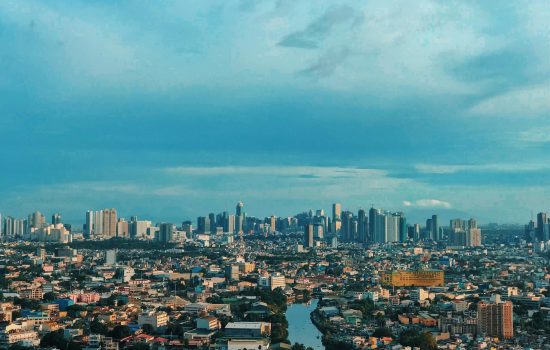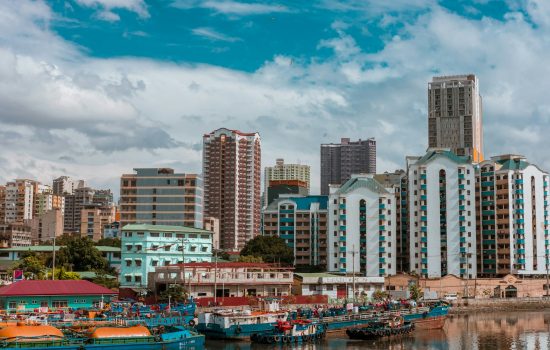Get a job in Manila
Thinking about living and working in Manila? It’s a cool city with modern buildings, old churches, and super friendly people. It’s cheaper to live here than most places in Asia. Their delicious food is also worth mentioning. Just a heads up, Manila can get crowded with lots of cars, so be prepared for traffic jams. There are many jobs to be found within and outside the centre, so if you’re up for an adventure, Manila is an awesome place to call home.

Life in Manila
The Philippines’ capital, Manila, is an energetic diverse city that combines the old and modern. There is a wide range of international retail outlets, dining options, recreational facilities, parks, and museums. The cost of living is significantly lower than most capital cities, making dining out affordable. It’s a safe city with an a big expat community, and many clubs and social opportunities. The city offers a diverse range of attractions, including music, theater, and restaurants in Makati and Bonifacio Global City. Furthermore, there are beach towns with world-class marine life in Batangas.
Work in Manila
- Average working hours per week: An average workweek of around 40 hours, similar to many places
- Typical working day: Monday to Friday from 9:00 am to 5:00 or 6:00 pm
- Number of Vacation days: You’ll usually get at least two paid vacation days per week, some companies might even offer more
- Commute: Trains and Jeepneys
- Work culture: Filipinos are known for being friendly and respectful. Expect to be addressed as “Sir” or “Ma’am” by your superiors as a sign of respect

FAQ
You can move to Manila by yourself, with a friend or as a couple. There are pros and cons to all of the situations. If you consider moving abroad with any kind of friend it can be a really good idea to sit down and talk through practical and everyday stuff such as economy, bills, cleaning, grocery shopping, cooking vs ordering, going out/staying in, how you deal with potentially going out without each other as well as having friends and family visiting (from near and far and extended visits). Apart from the practical arrangements, life is fun when you can share your new core memories with other people – so it is very recommendable to move abroad together. Moving with a friend can cause you to interact less with new people compared to if you move abroad by yourself. But if this is a good or a bad thing entirely depends on your personal goals and wishes as well as your personality.
Conclusion: communication is key if you and your friend decide to move abroad together.
Manila offers a variety of transportation options for travelers. For the adventurous, jeepneys are the most affordable and fun option, while tricycles are quick and cheap for short distances. The LRT/MRT are faster and air-conditioned alternatives, but can get crowded during rush hour. Taxis are available and affordable, but use the meter to avoid inflated fares. Apps like Grab are also convenient. Buses are suitable for longer distances but can be tricky for newcomers. Walking is less practical due to Manila’s hot weather and long distances.
When choosing your ride, consider the distance, time, budget, and comfort. Jeepneys and buses are the cheapest, while taxis and uber apps are more convenient but pricier. Embrace the adventure and enjoy the ride in Manila.
Manila offers a diverse range of housing options to suit different budgets and lifestyles. Apartments, condos, and houses are popular choices, with apartments being popular in the city center and condos being part of larger buildings with amenities like pools, gyms, and security. Houses, on the other hand, are found in suburbs or nearby cities and offer more space and privacy but may come with higher prices.
To find your new home in Manila, use online listings platforms like Lamudi, Dot Property, and https://www.point2homes.com/PH, real estate agents, and social media groups. Consider factors such as budget, location, amenities, and safety when choosing a property.
Schedule viewings to get a feel for the space, natural light, and overall vibe of the place, ask questions about utilities and pet policies, and read the contract carefully before signing a lease agreement. With some planning and research, you can find the perfect place to call home in Manila’s vibrant city.
Manila experiences two distinct seasons due to the tropical monsoon climate, with dry seasons from December to May and wet seasons from June to November. The city experiences a humid and sticky environment, but the sea breeze helps alleviate the high temperatures and humidity. The best time to visit Manila is from January to April, with average temperatures around 27°C. Rainfall is rare, with an average maximum of 6 rainy days per month. December and May are also good times, but December tends to be very humid and May is generally uncomfortably hot. The wet season from June to November is not pleasant, with humidity and flooding. Despite this, temperatures rarely fall below 20°C during the wettest months, August and September. To visit Manila during the low season, pack lightweight, breathable clothes and a raincoat.
Still not sure about moving to Manila?
Manila is a city that offers pretty much everything: chaotic charm of jeepneys, delicious smells of street food, the warmth of a Filipino smile, and an awesome expat life. It can be overwhelming at times, but that’s also what makes it so exciting. Most Filipinos speak Tagalog, but English is pretty common too.
Manila isn’t a polished postcard, it’s a real, vibrant city with a rich history and a whole lot of heart. If you’re looking for a place that pushes you outside your comfort zone and rewards you with delicious eats, friendly faces, and an unforgettable experience, then Manila might just be your perfect match.
THere are four airports so it’s easy to travel to other Asian cities like Bangkok, Jakarta, Ho Chi Minh, and Singapore. And two of the 7107 islands of the Philippines has been voted as the best in the world, with Boracay and Palawan remaining the country’s top destinations.
Don’t let a little uncertainty hold you back. Do some research, book a discovery trip (trust us, the street food alone is worth it), and see for yourself if Manila’s magic resonates with you. After all, the biggest adventures often start with a leap of faith. Ready to jump into the heart of Manila?

